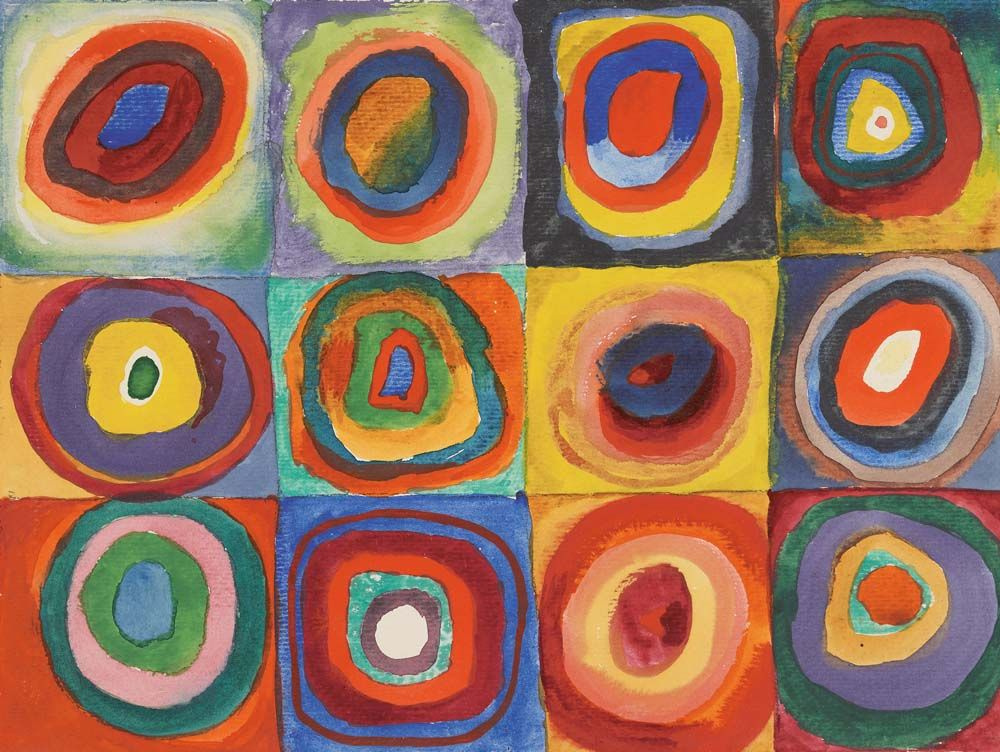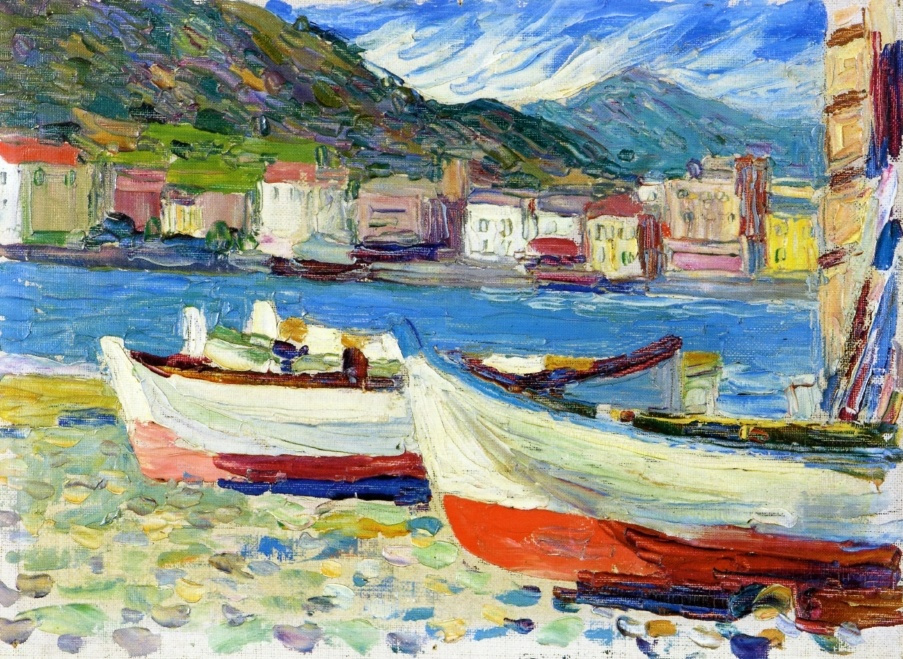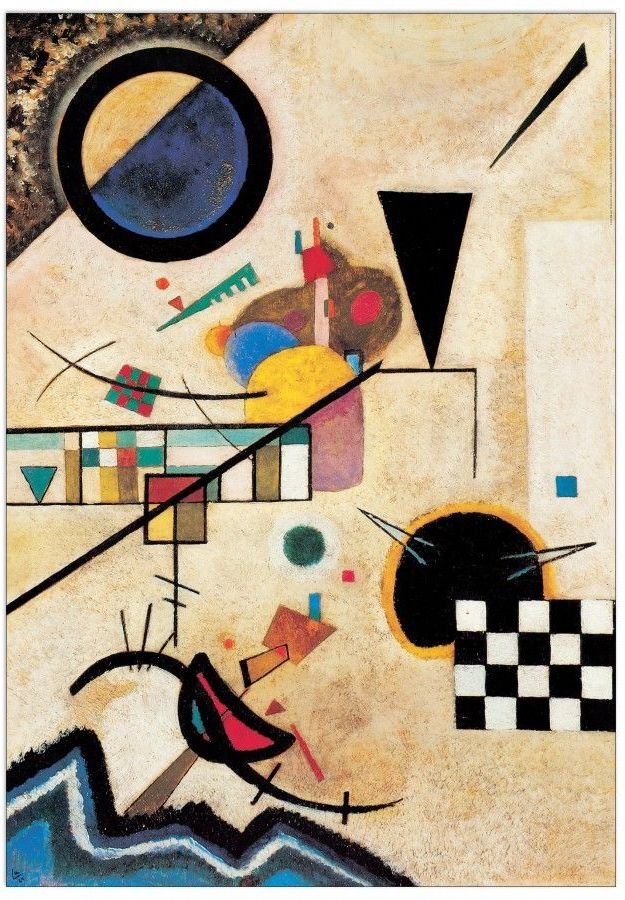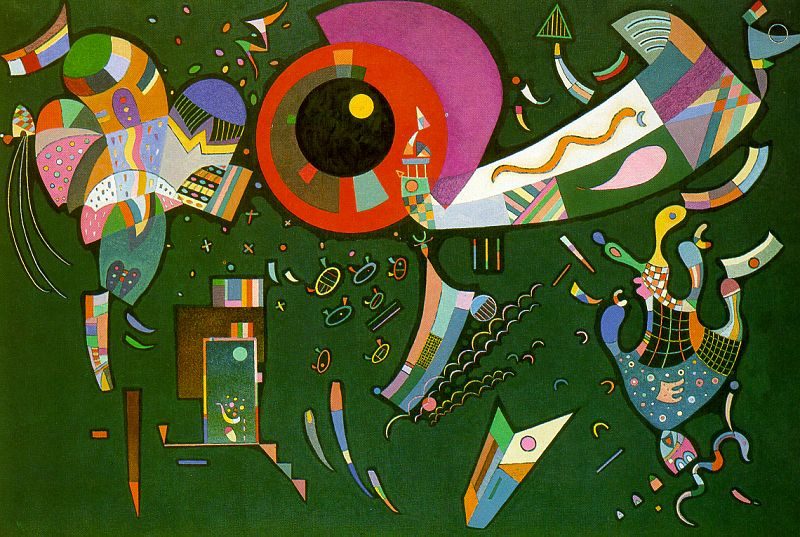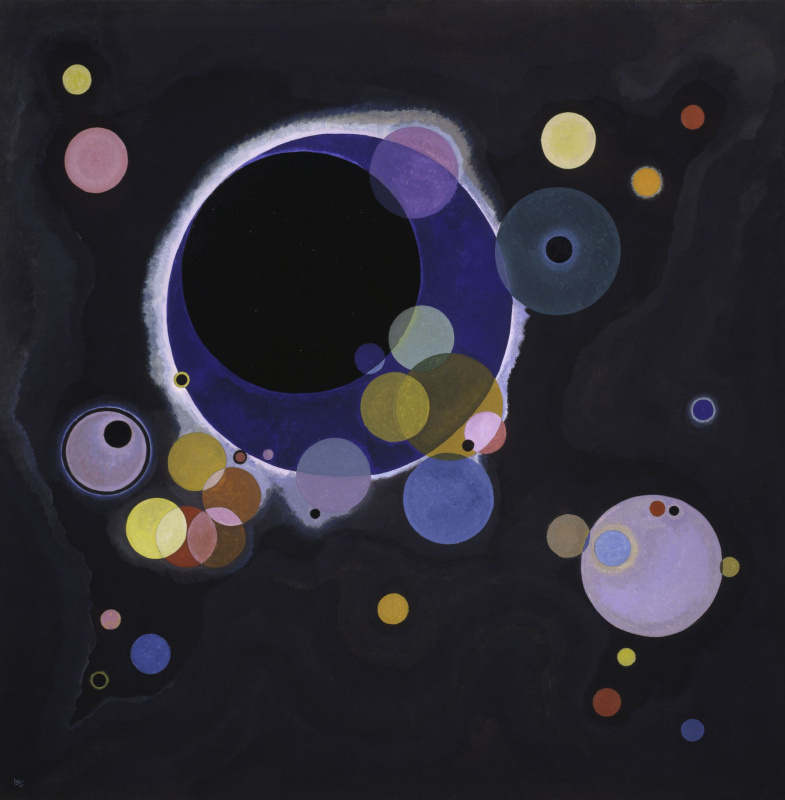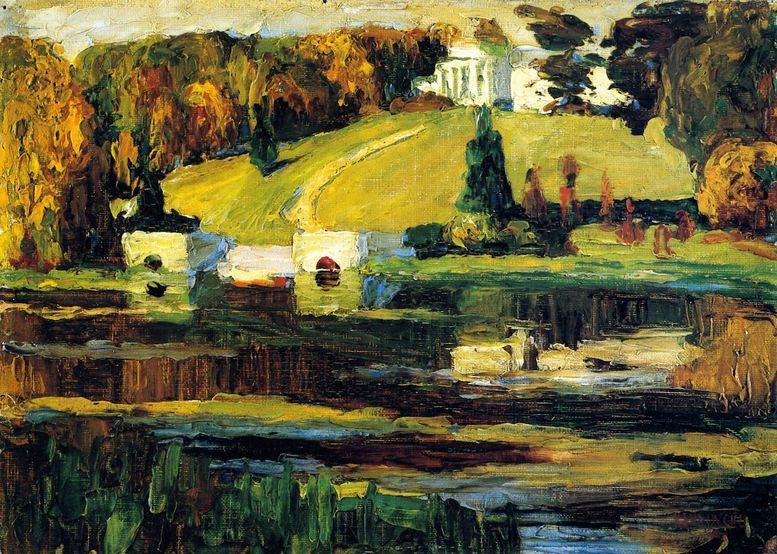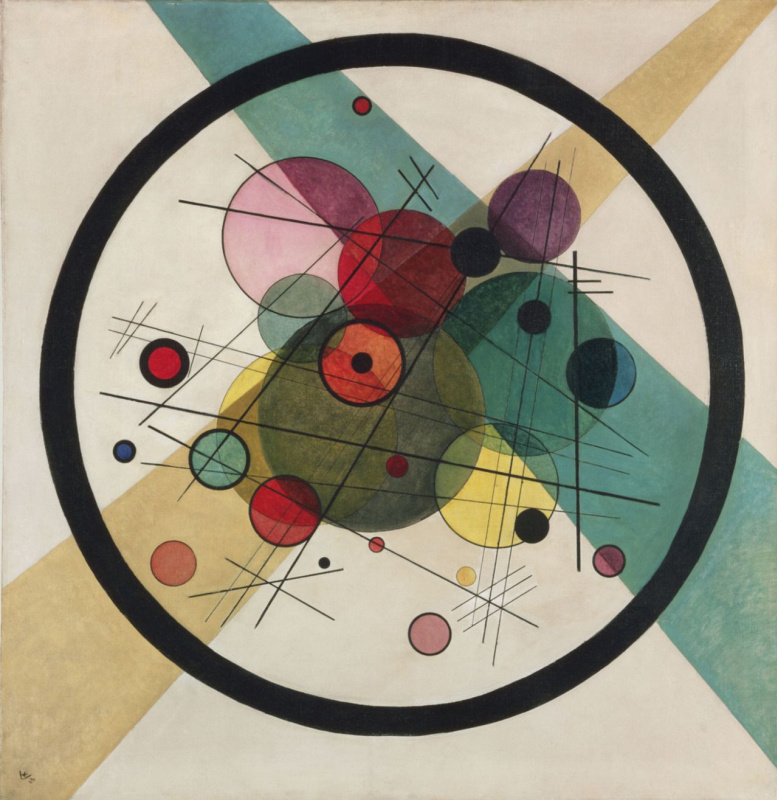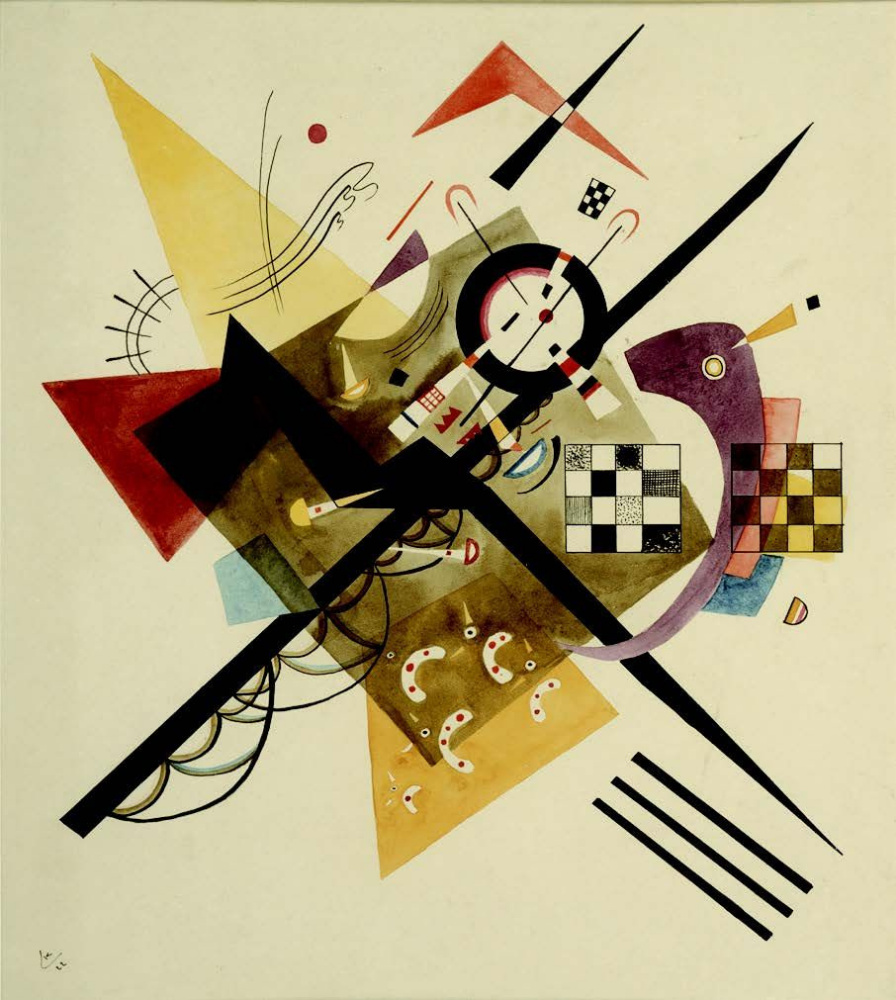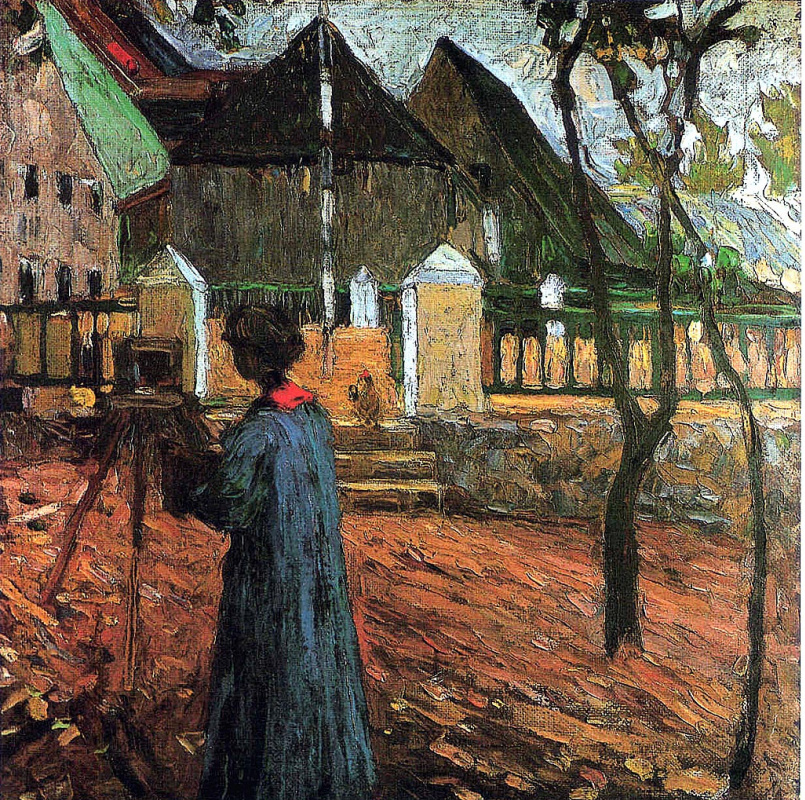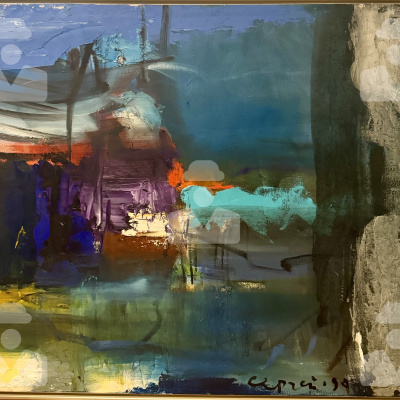Wassily Kandinsky except for his artistic genius and musical talent had an amazing ability to express his thoughts and ideas on paper. Two of his most famous books — "On the Spiritual in Art" (1910) and "Point and Line to Plane" (1926) — for many decades do not lose their relevance and have served as a valuable "guide to action" for beginners in many areas of the fine arts. Kandinsky almost never spoke about his private life although it was not under the seven seals. Mundane thoughts about material world just not perpetuated, for the artist’s mind was occupied completely by art.
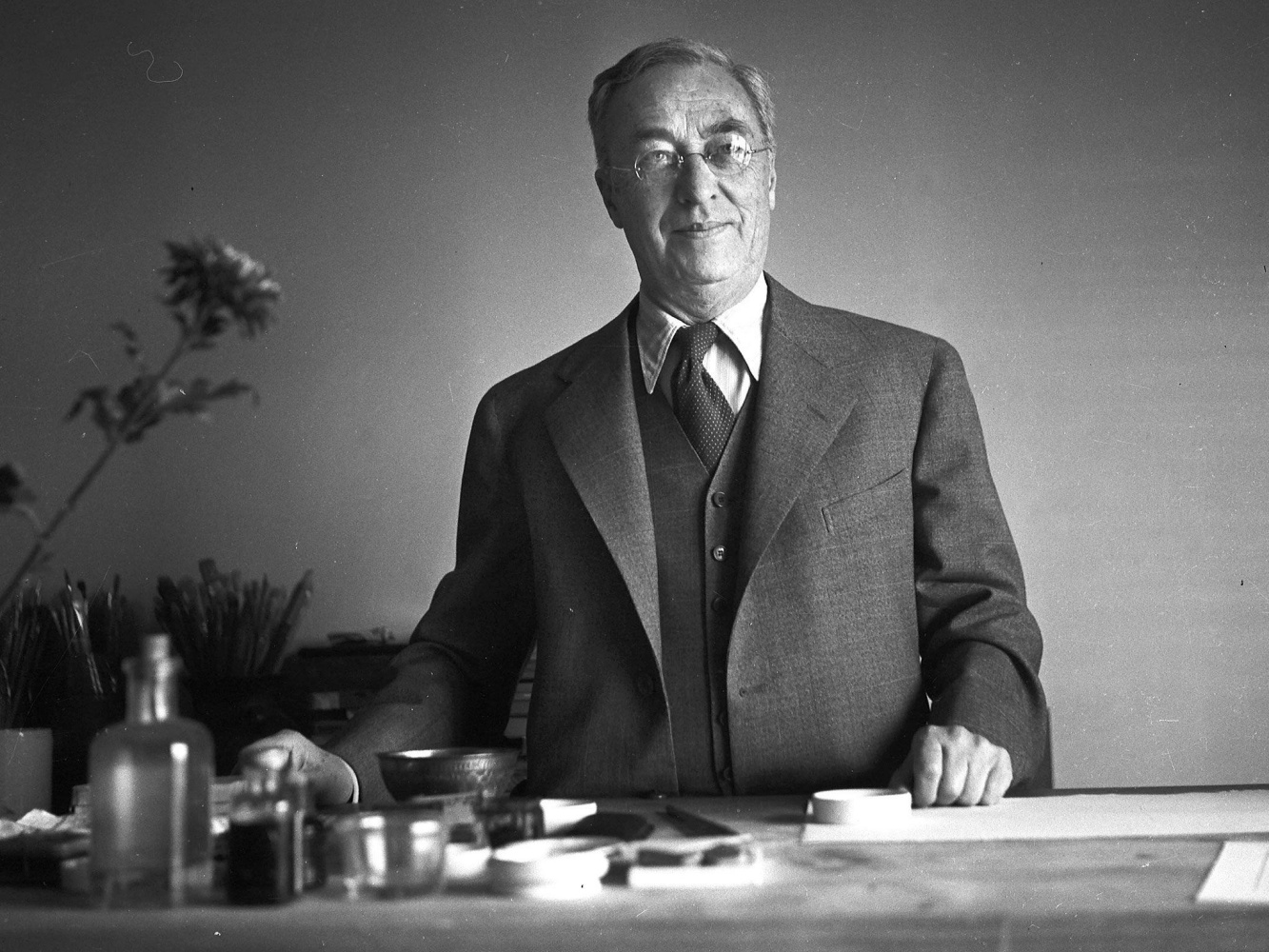
Color study: squares with concentric circles
1913, 23.8×31.4 cm
A totally dead silence, on the other hand, a silence with no possibilities, has the inner harmony of black…
Black is something burnt out, like the ashes of a funeral pyre, something motionless like a corpse. The silence of black is the silence of death. Outwardly black is the colour with least harmony of all, a kind of neutral background against which the minutest shades of other colours stand clearly forward. It differs from white in this also, for with white nearly every colour is in discord, or even mute altogether.
It is a strange fact that although the impressionists destroyed the last remnants of painting theory in their fight against "academicism," they immediately—though unconsciously—laid the first foundation stone of a new science of art, despite their contention that nature is the only theory for art.
Black is something burnt out, like the ashes of a funeral pyre, something motionless like a corpse. The silence of black is the silence of death. Outwardly black is the colour with least harmony of all, a kind of neutral background against which the minutest shades of other colours stand clearly forward. It differs from white in this also, for with white nearly every colour is in discord, or even mute altogether.
It is a strange fact that although the impressionists destroyed the last remnants of painting theory in their fight against "academicism," they immediately—though unconsciously—laid the first foundation stone of a new science of art, despite their contention that nature is the only theory for art.
Boats. Rapallo
1905
Every work of art is a thing-in-itself. Every work of art is an independent life. It is an original universe which is completely self-sufficient.
There is no greater evil than the understanding of art. Two age-old and eternally young laws accompany all spiritual movements: the fear of the new, hatred to what has not yet been experienced and impetuous tendency to hang to this new, not yet gone through, the etiquette, killing the life itself.
Painting is an art, and art is not vague production, transitory and isolated, but a power which must be directed to the improvement and refinement of the human soul—to, in fact, the raising of the spiritual triangle. If art refrains from doing this work, a chasm remains unbridged, for no other power can take the place of art in this activity.
The cock’s crowing, the door’s creaking, the dog’s barking, however cleverly imitated on a violin, can never be estimated as artistic accomplishments.
There is no greater evil than the understanding of art. Two age-old and eternally young laws accompany all spiritual movements: the fear of the new, hatred to what has not yet been experienced and impetuous tendency to hang to this new, not yet gone through, the etiquette, killing the life itself.
Painting is an art, and art is not vague production, transitory and isolated, but a power which must be directed to the improvement and refinement of the human soul—to, in fact, the raising of the spiritual triangle. If art refrains from doing this work, a chasm remains unbridged, for no other power can take the place of art in this activity.
The cock’s crowing, the door’s creaking, the dog’s barking, however cleverly imitated on a violin, can never be estimated as artistic accomplishments.
Contrasting sounds
1924, 70×49.5 cm
Circle is the synthesis of the greatest opposites. It combines concentric and eccentric in a sole form and keeps it in balance. Of the three primary planes (triangle, square, circle), it most clearly points on the fourth dimension — time.
The sound of that silence customarily connected with the point is so emphatic that it overshadows the other characteristics.
External feasibility and practical value of the whole surrounding world have covered the inner essence of visible and audible by the dense veil. This thick curtain conceals from us the inexhaustible material of art.
The sound of that silence customarily connected with the point is so emphatic that it overshadows the other characteristics.
External feasibility and practical value of the whole surrounding world have covered the inner essence of visible and audible by the dense veil. This thick curtain conceals from us the inexhaustible material of art.
Around the circle
1940, 96.8×146 cm
Colour is the keyboard, the eyes are the hammers, the soul is the piano with many strings. The artist is the hand which plays, touching one key or another, to cause vibrations in the soul.
It would be better, perhaps, if instead of "dark green" I wrote, for example, "space forces" or instead of "several circles" — "circles in infinity"! My names give the impression that my pictures are somewhat insignificant and boring. But too pretentious names sicken me. In general, I think the names are the necessary evil, since they, as well as the subject, always limit rather than expand.
It would be better, perhaps, if instead of "dark green" I wrote, for example, "space forces" or instead of "several circles" — "circles in infinity"! My names give the impression that my pictures are somewhat insignificant and boring. But too pretentious names sicken me. In general, I think the names are the necessary evil, since they, as well as the subject, always limit rather than expand.
Several circles
1926, 140×140 cm
When excluding the objectivity from painting, essentially, high requirements are set to the ability of experiencing a pure art form. Therefore, a viewer is required a special development in this direction, which is inevitable.
When religion, science and morality are shaken, the two last by the strong hand of Nietzsche, and when the outer supports threaten to fall, man turns his gaze from externals in on to himself.
I myself do not always understand it, but I often hear claims that the contact with nature affects my painting. Indeed, it’s immediately noticeable that my journeys, for example to Africa or Palestine, have not passed for me in vain. As to my emigration to Paris, it has radically transformed my palette.
When religion, science and morality are shaken, the two last by the strong hand of Nietzsche, and when the outer supports threaten to fall, man turns his gaze from externals in on to himself.
I myself do not always understand it, but I often hear claims that the contact with nature affects my painting. Indeed, it’s immediately noticeable that my journeys, for example to Africa or Palestine, have not passed for me in vain. As to my emigration to Paris, it has radically transformed my palette.
Romney. Autumn
1901
Even one color or one single form can be raised to the level of composition.
As years passed, I realized that working with feverishly pounding heart, chest pressure (and hence with pain in ribs), as well as tension throughout the whole body, does not give perfect results: after such ardor, when self-control and self-criticism even disappears for some minutes, the imminent fall comes quickly.
Today a point sometimes says more in a painting than a human figure. Vertical line in conjunction with a horizontal line gives no lesser dramatic sounding. Clash of a circle with an acute angle of a triangle gives no lesser effect than the approach of the finger of God to the finger of Adam on fresco painting by Michelangelo.
As years passed, I realized that working with feverishly pounding heart, chest pressure (and hence with pain in ribs), as well as tension throughout the whole body, does not give perfect results: after such ardor, when self-control and self-criticism even disappears for some minutes, the imminent fall comes quickly.
Today a point sometimes says more in a painting than a human figure. Vertical line in conjunction with a horizontal line gives no lesser dramatic sounding. Clash of a circle with an acute angle of a triangle gives no lesser effect than the approach of the finger of God to the finger of Adam on fresco painting by Michelangelo.
Circles in circle
1923
In the days of great importance, spiritual atmosphere is so saturated with a certain aspiration and with the necessity so accurately expressed, that it is easy to become a prophet. These are general rotation periods, the times when inner maturity, hidden from superficial glance, gives an irresistible impetus to the spiritual pendulum. This is the pendulum, which appears to the same superficial eye as a subject swinging always in one and the same device. It rises naturally up, remains an instant at the top and embarks on a new path in a new direction. Surprisingly, it’s almost inconceivable that the "crowd" does not believe this "prophet."
Each period of a civilisation creates an art that is specific in it and which we will never see reborn. To try and revive the principles of art of past centuries can lead only to the production of stillborn works.
Each period of a civilisation creates an art that is specific in it and which we will never see reborn. To try and revive the principles of art of past centuries can lead only to the production of stillborn works.
In white II
1923
This nightmare of materialism, which has turned the life of the universe into an evil, useless game, has not yet past. The awakening soul, while trying to free itself, is still under its domination.
A painter who finds no satisfaction in the mere representation of natural phenomena, however artistic, who strives to create his inner life, enviously observes the simplicity and ease with which such an aim is already achieved in the non-material art of music. It is easily understandable that he will turn to this art and will attempt to reciprocate it with his own medium.
The artist is not a 'Sunday child' for whom everything immediately succeeds. He does not have the right to live without duty. The task that is assigned to him is painful, it is a heavy cross for him to bear.
A painter who finds no satisfaction in the mere representation of natural phenomena, however artistic, who strives to create his inner life, enviously observes the simplicity and ease with which such an aim is already achieved in the non-material art of music. It is easily understandable that he will turn to this art and will attempt to reciprocate it with his own medium.
The artist is not a 'Sunday child' for whom everything immediately succeeds. He does not have the right to live without duty. The task that is assigned to him is painful, it is a heavy cross for him to bear.
Gabrielle Münter at painting
1903, 58.5×58.5 cm
With few exceptions and deviations, music has, for centuries, been the art which has used this means, not so much to represent natural phenomena but rather, as an expression of the artist’s spiritual life and to the creation of a unique life of musical sounds.
The deeper the blue, the more it beckons man into the infinite, arousing a longing for purity and the supersensuous. It is the colour of the heavens just as we imagine it, when we hear the word 'heaven'.
Lend your ears to music, open your eyes to painting, and… stop thinking! Just ask yourself whether the work has enabled you to 'walk about' into a hitherto unknown world. If the answer is yes, what more do you want?
The deeper the blue, the more it beckons man into the infinite, arousing a longing for purity and the supersensuous. It is the colour of the heavens just as we imagine it, when we hear the word 'heaven'.
Lend your ears to music, open your eyes to painting, and… stop thinking! Just ask yourself whether the work has enabled you to 'walk about' into a hitherto unknown world. If the answer is yes, what more do you want?
Singer
1903, 19.5×14.5 cm
The spirit, like the body, can be strengthened and developed by frequent exercise. Just as the body, if neglected, grows weaker and finally impotent, so the spirit perishes if untended.
Main photo: Wassily Kandinsky in Paris, 1936
Collected by Evgenia Sidelnikova.
Main photo: Wassily Kandinsky in Paris, 1936
Collected by Evgenia Sidelnikova.






